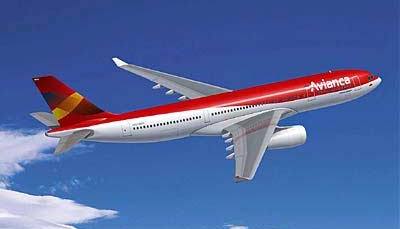
AVIANCA AIRLINES

 |
Bogota, the capital of Colombia and the
4th largest city in South America, with a population of seven million is very
cosmopolitan; residents are elegant and its streets are safe, clean and
happening. Signs of Bogotá’s urban
rebirth are everywhere: from its vibrant restaurant scene to its world class
museum exhibitions, high fashion shopping neighborhoods, edgy fashion designers
and the Sunday flea markets (mercado pulgas). Architectural award winning
condos, a sign of increasing prosperity, rise in contrast to
La Candelaria, the colonial old section
of town, where narrow streets are yours to explore, and charming old houses
offer unexpected architectural treasures.
Bogotá’s colleges and universities have
a major impact on the city and region's economy. Not only are they major
employers, but they also attract national and international industries to the
city and surrounding region, including highly needed technology industries. The
city is Colombia's educational " Mecca".
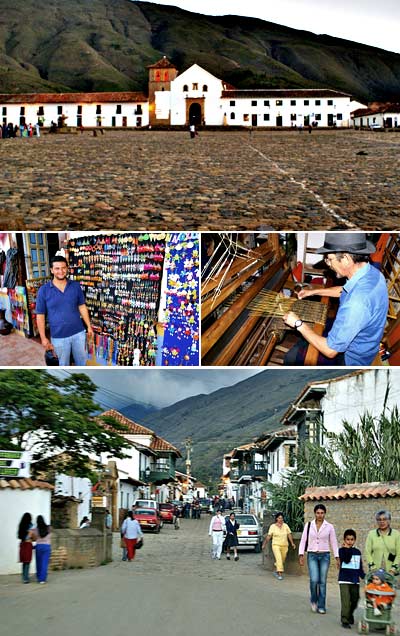 |
|
Villa de Leyva |
Diana Rodriguez, a young intern with
Proexport, meets us at the airport; we
drive three hours for an overnight stay in
Villa de Leyva, a charming old colonial religious town with cobblestone
streets and a beautiful church on the town square. On weekends the square and
narrow streets come alive with musicians and artisans selling hand woven crafts.
Unfortunately it is a week day, and the town is quiet. We wander in and out of
small family owned shops and bargain for hand loomed ponchos. The workmanship is
exquisite, and the people are happy to share a little local gossip. We stop in a
tiny cafe for a sweet treat and a refreshing frozen fruit drink; I wander into a
local art gallery.
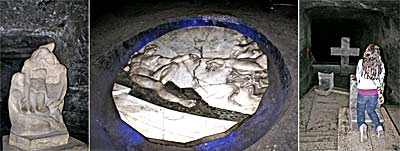 |
|
The Salt Catheral |
On the way back to Bogotá we make a
detour to visit the underground Salt Cathedral, built for the miners who worked
the mines. Altars and chapels have been carved out of stone and marble. It is
eerie to sit on a stone pew in an underground chapel.
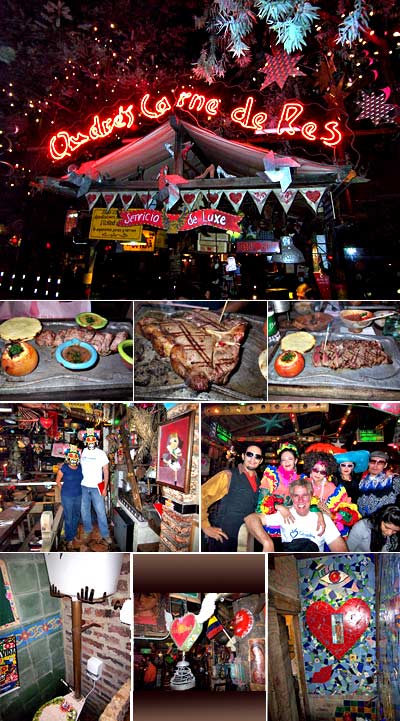 |
|
Andres Carne de Res Restaurant |
It is dinner time when we reach Chia, on
the outskirts of Bogotá, and
Andres Carne de Res Restaurant. We are
treated to an evening of mayhem, a zany wait staff of over 100, and fabulous T
bone steaks cooked to perfection on open grills. Confusion reigns; the décor is
a happening in itself; Andres has spent 25 years collecting whimsical and
outrageous bits, pieces and antiques for this mad hatter watering hole. Locals
and tourists come here to eat, drink and dance. .. . both on the dance floor,
and on the tables. A group of costumed performers meander the rooms, working the
audience with humor and audacious behavior. To quote another journalist “The
Andres experience is representative of what the world misses by not going to
Colombia” It is indeed profoundly creative, tumultuous, confusing and fattening
all at the same time.
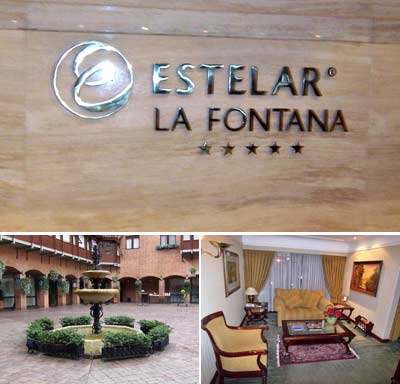 |
|
Hotel Estelar La Fontana |
My two bedroom suite, with three bathrooms and a kitchen, at the prestigious
Hotel Estelar La Fontana is huge, well
appointed and ideal for entertaining. Too bad there wasn’t more time to enjoy
its elegant classic décor. However, the hotel’s delicious Colombian breakfast
buffets, served in the La Fontana Restaurant and al fresco in the courtyard
(included in my stay), was a not to be missed morning ritual. After a day of
sight seeing and shopping, the restaurant’s
ajiaco, a typical Colombian chicken, potato and avocado stew, was a
welcome treat. On special Sundays, the
hotel courtyard is filled with artisans selling a wide variety of handicrafts.
The traffic in Bogotá moves at a crawl
(there are more than 50,000 taxis), but fares are cheap. From
Hotel La Fontana on 127th Street down to
the Old Section costs less than $7, and
to Zone T and
Zone C, about $4.
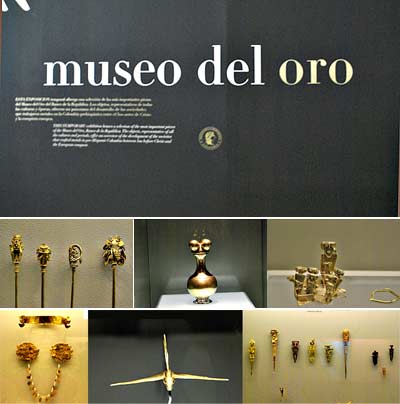 |
|
The Gold Museum |
Bogotá is a treasure trove of culture,
exuberant history and creativity. There are more than forty world class
museums; the Gold Museum houses the
largest collection of Pre Colombian gold works in the world. It is a city of
ethnic festivities and ongoing celebrations. The restaurant and nightclub scene
is vibrant and elegantly dressed; the cultural calendar of art, film, jazz,
opera and fashion events is impressive. Highlights include:
The Artists Salon,
The Bogotá Film Festival,
Rock & Jazz in the Park,
The Opera and Zarzuela Season, and the
International Book Fair.
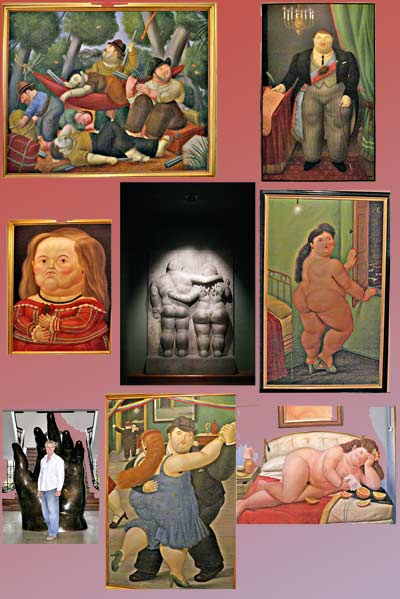 |
|
The Botero Museum |
We wander the narrow colorful streets . . . churches, colonial mansions and
republican buildings are proud tributes to Colombia’s past. Many have taken on a
new life after being converted into hotels, restaurants, theaters and museums.
The Gold Museum, (
Museo del Oro, Calle 16, 5-41) is
temporarily closed for renovation; we view a smaller collection of gold
artifacts at the Botero Museum, (calle
11, No. 4-21) Colombian painter and sculptor
Fernando Botero, known for his oversized figures, has donated an
impressive collection of 123 of his own work, as well as pieces from his private
collection, including Picasso, Matisse, Leger, Renoir and Monet.
Corferias, the fair and convention
center of Bogotá, is the scene of a
wholesale food exposition; we wander from booth to booth tasting food products
from around the world.
I think of food as what it looks like when served, what it does for me, and how
it makes me feel. Colombian food has much to offer even the most discriminating
palates. Whether dining on robust traditional dishes at
La,
fusion cuisine at Harry Sasson, the best
seviche I’ve ever tasted at
Club Colombia (their menu features
seviche marinated twelve different ways), or the gourmet specialties I sampled
at Cocina y Cava, my emotions ran
high. I was impressed with the range of creativity, both in the tastes and the
plating presentations.
Leo Katz,
Bogotá’s most innovative gastronomic
entrepreneur, thrives on challenges; he and celebrity chef
Harry Sasson deserve accolades for their
role in turning Zona Rosa and
Zone T( a neglected neighborhood) into a
vibrant restaurant, nightclub and trendy boutique district . . . a mix of
Bohemian chic with edgy couture, similar to New York’s Soho or Meetpacking
District. Leo Katz has just ended his
weekly staff meeting. He tells me: “I started with one donut shop, added a
hamburger place then a diner. Today I have 22 restaurants, a bakery my parents
run, and The Donut Factory, a chain of
16 donut shops. The Colombian Coffee Growers
asked me to develop a chain of coffee shops, like Starbucks, but I could
only use 100% Colombian coffee, unlike Starbucks that serves different flavored
coffees from around the world. To meet this challenge, I drew on Colombia’s
coffee growing regions with climates that produce a wide variety of coffees with
different characteristics”. Leo is very
passionate about the future of Bogotá
and welcomes help in building confidence in people who visit. Lunch at
Harry Sasson elevates my taste buds for
fusion cuisine to a higher level of appreciation.
 |
|
Rosario Rueda, note Rosario with the First Lady - rgt to lft: Rosario Rueda, Lina Moreno De Uribe, Colombia'a first lady and "the Duchess" |
Rosario Rueda
is an interior designer
and a partner in an architectural design firm. On a trip to South America she
found beautiful materials that inspired her to combine silver and stones with
leather in a natural way. Two years ago she opened the
Rosario Rueda Boutique at Carrera 14A
# 8324 in the Calle del Sol
neighborhood to showcase her personally designed collection of handbags, belts
and buckles . . . and to sell the work of six other designers. She tells
me: “our idea is to carry exclusive and unusual clothing and accessories to suit
all personalities and generations, from twenty years to sixty years; what you
will find here is art to wear”, which is exactly how best to describe
Rosario’s changeable stone and silver
belt buckles, suede and skin belts, cow horn handle classic bags . . . and
artist/designer Helena Caballero’s one
of a kind embroidered, painted and beaded jackets.
Helena Caballero, one of
Rosario’s special designers, has just
arrived with new jackets; I spend hours trying them on, admiring all the
treasures in the store, and chatting about fashion in
Bogotá.
Rosario’s mother who I nicknamed the
“duchess” helps run the shop. Helena,
who attended the Rhode Island School of Design
and studied painting in Milan, started embroidering an old jacket as therapy
when her husband became ill. “After he died, it helped me mentally and
economically. I found other women who were needy and set up a cottage industry
to transform their lives. I now have 24 ladies who are happy and proud. My goal
is to continue to join my love of painting to make very special one of a kind
pieces to sell in the United States”.
My friend Francisco Vergara’s mom and
sister own Los Arrieros, a neighborhood
restaurant serving fonda pura antioquera, (homemade typical Colombian meat,
fish, and rice and beans dishes) in a simple, comfortable, and homey
atmosphere. They spoil me as Colombian mamas do their own children with an
array of home made dishes that rate high on my comfort food recommendation list.
Now that Avianca Airlines flies non stop
from New York to Bogotá 12 times a week,
and non-stop from Washington, D.C, Miami, Ft. Lauderdale, Atlanta, Houston and
LA. with very affordable fares, I highly recommend a visit to this cultural and
fun treasure, “the only risk will be wanting to stay”.
For more info on Colombia:
www.visitcolombia.com
or
www.bogotaturismo. gov.co
For Avianca Airlines reservations:
www.avianca.com
Brief History
Bogotá, originally called
Bacatá by the Muiscas, was the center of
their civilization before the Spanish conquest, and sustained a large
population. The European settlement was founded in August 6, 1538, by
Gonzalo Jiménez de Quesada and was named
" Santa Fé de Bacatá" after his
birthplace Santa Fé, and the local name.
" Bacatá" had become the modern "
Bogotá" by the time it was made the
capital of the vice-royalty of New Granada,
and the city soon became one of the centers of Spanish colonial power and
civilization in South America.
In 1810-11 its citizens revolted against Spanish rule and set up a government of
their own, but had to contend with Spanish military loyalists, who controlled
the city until 1819, when Simón Bolívar
captured the city after his victory at Boyacá.
Bogotá was then made the capital of Gran
Colombia . . . a federation combining the territories of modern Panama,
Colombia, Venezuela, and Ecuador. When that republic was dissolved into its
constituent parts, Bogotá remained the
capital of New Granada, which later became the Republic of Colombia. In August
2000 the capital's name was officially changed back from "
Santa Fé de Bogotá" to the more usual "
Bogotá."